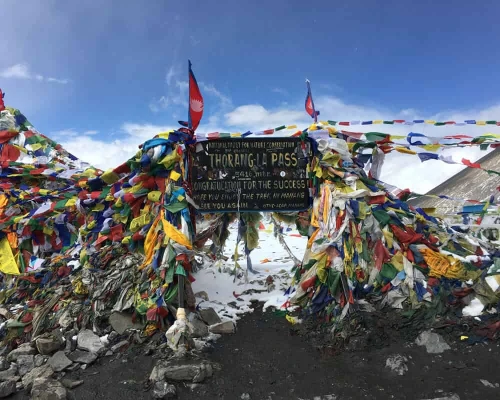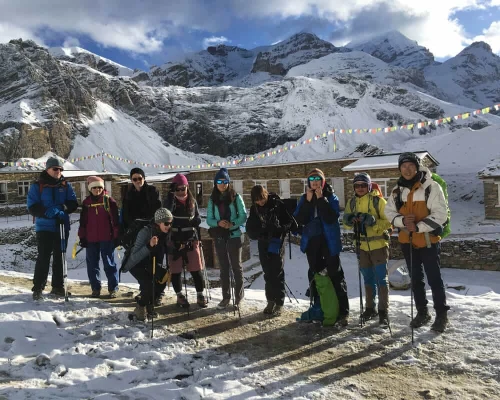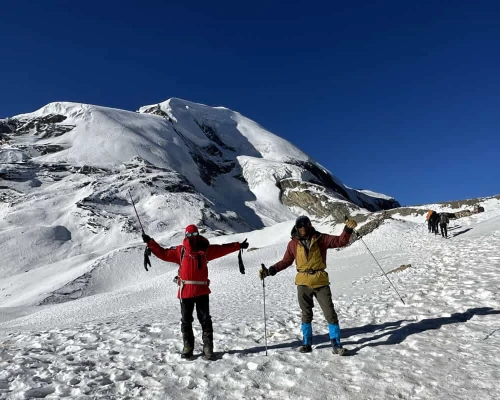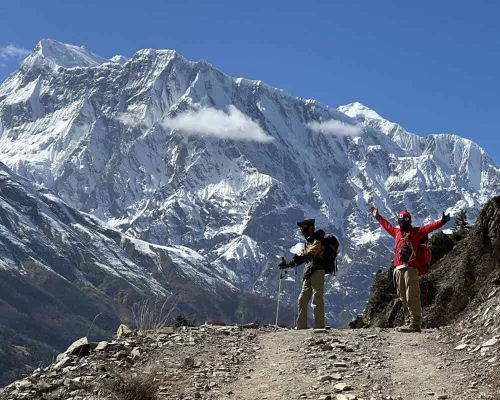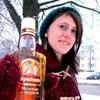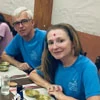Annapurna Circuit Trek 14 Days Highlights
- Scenic Drive from Kathmandu to Dharpani.
- Trekking through five different constituencies of Nepal: Lamjung, Manang, Mustang, Kaski, and Myagdi.
- Opportunity to witness the rich cultural diversity.
- Experience the legendary Salt Trade Route that passes through time-honored settlements with exceptional scenic beauty.
- The magical view of enormous soaring snow-clad mountains
- Witness the miraculous transformation in vegetation as you ascend higher.
- The grand view of the Annapurna range, Gangapurna, Lamjung, Tilicho, and Chulu is phenomenal.
- Crossing the Thorong La Pass (5416 m/17,769 feet), the highest point in the Annapurna circuit trek.
- Visit to Muktinath Temple, a very sacred place for both Hindus and Buddhists is another highlight of the trip.
- The thrilling flight from Jomsom airport 2720 m to Pokhara (820 m/2690 ft) through the valley of Kali Gandaki, the world’s deepest gorge.
Annapurna Circuit Trek 14 Days Overview
This 14-day epic Annapurna Circuit Trek takes you to the spiritual land that was once the world's number-one trekking destination. The Annapurna Circuit Trek 14 Day is by far the most admired and beautiful trekking destination of all. This 14-day classical trek route once served as a fundamental salt trading route between Nepal and Tibet.
Figuratively, this ancient salt trading route has so much variety to deliver to travelers. It certainly offers anyone with varied topographic settings, history, culture, and pictorial luxury.
Moreover, it gives you ample opportunity to understand the culture of the people popularly known as Gurungs. It is very wisely said that 'if you want to understand the culture of Nepal, go for the Annapurna circuit trek”. That’s because the range of variety that this trek offers to the people is indeed very unique nowhere to be found.
The Annapurna Circuit Trek is certainly an extraordinary journey that provides you with the true magic of the Himalayas. You will find yourself surrounded by towering snow-capped peaks, lush green valleys, and charming traditional villages.
The magic of the Annapurna Circuit lies when it transports you to the most dramatic natural amphitheater. Here you will realize the magic of nature and how it connects with your soul. Each step brings you closer to the majestic Annapurna massif, offering breathtaking views.
The topographical diversity is diverse and takes you from dense forests to arid high-altitude deserts. Along the way, you encounter the warm hospitality of the local communities, their colorful traditions, and their spiritual connection to the mountains.
As you navigate through the magical valley, and cross suspension bridges over roaring rivers you feel like you are transferred to a heaven-like region. The serenity that Annapurna Circuit Trek has to offer travelers is profound and cannot be found elsewhere. It is a pilgrimage of self-discovery, where you witness the raw power and timeless beauty of nature.
History of Annapurna Circuit Route:
The Annapurna Circuit route has a rich history deeply interwoven with the ancient Salt Trade Era. Long before it became a popular trekking destination, this route served as a vital trading route connecting Tibet and Nepal.
Salt was a scarce and valuable commodity in Nepal and was transported from the Tibetan highlands in a caravan of yaks and mules. In exchange, the traders from Nepal would barter grains which was again a necessity in the mountains. Legend has it that the people living in the Annapurna region played a crucial role as middlemen in this trade.
They helped guide traders through the challenging mountain terrain and with language translation during the exchange process. The people from nearby villages like Manang and Mustang often served as middlemen, guides, porters, or translators.
It is said that Thorong La Pass, 5,416 meters was exclusively used by traders and local people. Besides winter, the pass was accessible and was used frequently.
Locals narrate how they used to walk over the Thorong La during the wedding ceremony. If someone was to marry someone from Mustang to Manang or from Manang to Mustang, crossing this pass was mandatory then. It is said that the wedding attendants used to go over this pass and bring over the bride or groom from the other side.
However, all these traditions, cultures, and legends just became a part of history with the coming of tourism. The way of life began to change dramatically. Shortly after the evolution of the Annapurna Circuit trek began at a very rapid pace in the 1980s. The area gradually became from once a trading route to the world’s most popular trekking destination.
14 Days Annapurna Circuit Trek Trip Profile:
Annapurna Circuit Trek 14 Days cruises into the divine topography setting with deep gorges, high cliffs, majestic mountains, and ancient farming terraces. Moreover, this trek comprises five different constituencies of Nepal namely – Lamjung, Manang, Mustang, Kaski, and Myagdi.
Unlike EVEREST TREKKING the variety of natural decor and culture that it delivers to travelers makes it one of the most awe-inspiring destinations of all. The everyday shifting transformation in the vegetation and landscape from sub-tropical to desert and to the alpine is intensely fascinating. No wonder Annapurna Circuit Trek was once the No. 1 trekking destination in the world.
The trek starts off with a scenic drive to the village of Dharapani, our first destination. This beautiful drive gradually ascent from 900 meters through a tropical lush woodland region into the deep valley of Marshyangdi. Leaving Dharapani, following the stunning Marshyangdi gorge we will walk to the ancient settlement of Chame.
From Chame, gradually we will enter the Manang district and walk to the alpine settlement of Pisang with a remarkable view of snow-capped mountains. The very next day taking the most picturesque upper trekking route, we will walk to Nagwal. The mountain view you will witness from this point is simply incredible. You will have a grandiose view of Annapurna II, III, IV, Gangapurna, Tilicho, Tharke Kang, Manaslu, Chulu and Pisang Peak.
There isn’t anyone who wouldn’t enjoy a stopover in these spectacular local settlements that offer cozy homes to travelers. Gradually, we will get to the paradise-like Manang town that offers you a grandiose view of Annapurna massif which is simply phenomenal.
Leaving Manang now we enter into the alpine Annapurna Area. We will walk under the shadow of Chulu mountain and reach our destination of Yak Kharka at 4110 meters. We will walk the more alpine-desert area the next day and cross a few of the landslide areas with the risk of rockfall, caution is to be taken. Eventually, we will reach the Thorong Base Camp (Phedi) at 4450 meters where we will sleep overnight.
Going over the world’s highest navigable pass, Thorong La 5416 m / 17,769 feet is indeed very challenging yet very rewarding. After crossing the highest pass we will get to the most pious town of Muktinath. Here we will celebrate our accomplishment and treat ourselves with drinks and of course hot showers.
Now we are in a district of Mustang, which is arid dry, and more like Tibet. We will walk the Kali Gandaki Gorge now to get to our final destination of Jomsom. Enjoying your last night with your local staff in the windy valley of Jomsom is something very exciting. The morning flight to Pokhara in a small plane through the world’s deepest gorge, Kali Gandaki is unquestionably very thrilling.
This Annapurna Circuit Trek 14 Days is very thrilling and wouldn't disappoint anyone who so chooses to travel.
Likewise, you can also check for Annapurna Circuit with Tilicho Lake or trekkers also search for a combination trek of Annapurna Circuit and Annapurna Base Camp Trek.


